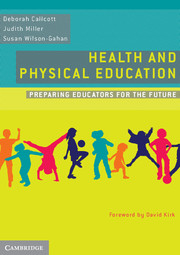Book contents
- Frontmatter
- Foreword
- Contents
- About the authors
- Acknowledgments
- Chapter 1 Introduction
- Chapter 2 The foundation of movement skills
- Chapter 3 Teaching inclusively
- Chapter 4 What all teachers need to know about movement
- Chapter 5 Pedagogy
- Chapter 6 Planning for teaching and learning
- Chapter 7 ICT and general capabilities in the Australian Curriculum
- Chapter 8 Assessment in health and physical education
- Chapter 9 Health education
- Glossary
- Bibliography
- Index
- References
Chapter 1 - Introduction
- Frontmatter
- Foreword
- Contents
- About the authors
- Acknowledgments
- Chapter 1 Introduction
- Chapter 2 The foundation of movement skills
- Chapter 3 Teaching inclusively
- Chapter 4 What all teachers need to know about movement
- Chapter 5 Pedagogy
- Chapter 6 Planning for teaching and learning
- Chapter 7 ICT and general capabilities in the Australian Curriculum
- Chapter 8 Assessment in health and physical education
- Chapter 9 Health education
- Glossary
- Bibliography
- Index
- References
Summary
Learning objectives
By engaging with the text in this chapter, students will be able to:
understand the framework of this book and the overall focus of pre-service teacher education (PSTE) for physical education, health and wellbeing across the early childhood, primary and secondary levels of schooling
understand the different terms associated with PSTE, levels of schooling, and the inclusion of health and physical education in the Australian Curriculum
delineate the areas of physical education, sport, physical activity, and play and understand these are related but not synonymous terms
understand and apply the principles of social justice to health and physical education as covered by the Australian Curriculum
recognise and appreciate the relevance and impact pre-service teachers’ past school experiences have on their ability to transform physical education, health and wellbeing of all students throughout their teaching career.
Casey is 22 years of age and has been working with young children since she was 16. Her reputation has many families in her town vying for her babysitting services. The local preschool sought her out to work with them and now, some years later, she is gaining a formal early childhood qualification. Casey is starting to understand many aspects of child development from a disciplinary and research point of view, confirming and enhancing many of her experiential ‘real-life’ interactions with children in her centre.
Ashleigh is excited. She loves all the units of study in the primary school-aged curriculum. However, Ashleigh is feeling anxious about EDPE247, the Health and Physical Education Pedagogy unit in her PSTE degree. She remembers how in school she excelled in strategies to avoid participation in physical education classes.
Bill is in the secondary physical education PSTE program. Having been accepted into the program, Bill feels confident that his strong athletic background and excellent sporting achievements will make it easy for him to succeed. He feels that these are key to making a difference with his secondary school-aged students. His students need a strong, skilled, competent and enthusiastic teacher to lead them across the areas of physical education and sport.
- Type
- Chapter
- Information
- Health and Physical EducationPreparing Educators for the Future, pp. 1 - 14Publisher: Cambridge University PressPrint publication year: 2012



